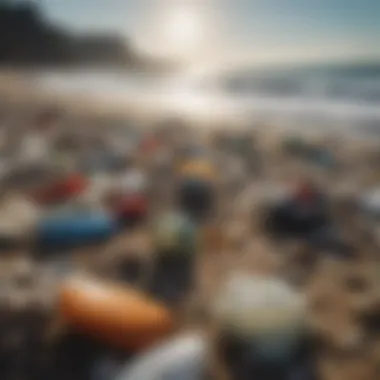Understanding Beach Pollution: Causes and Effects


Intro
Beach pollution stands as a pressing concern affecting not only our beloved coastlines but also the health of the entire marine ecosystem. With rising tides of waste washing ashore, it's essential to grasp the multifaceted nature of this issue. Understanding what type of pollution we’re dealing with and how each contributes to the degradation of our beaches is crucial.
In these times, where plastic is often seen floating in the waves and chemical runoff cloaks the sands, it's imperative to shine a light on the origin of these pollutants. By diving into the various types, we can begin to understand their consequences — both for marine life, which suffers from ingestion and entanglement, and for people who seek leisure and nourishment from these waters.
This article aims to illuminate the shadowy corners of beach pollution through a blend of facts and insights. We will dissect the intricate web of causes behind this environmental crisis, explore its ripple effects through marine food chains, and ponder the health repercussions for those who venture to our coastlines.
In the face of this reality, it is also crucial to explore avenues toward mitigation. From effective community actions to individual responsibility, there are many routes we can take to join the formidable fight against beach pollution.
As we embark on this journey, let’s grasp how beach pollution is not just an isolated problem but a reflection of broader environmental challenges. Together, we can foster a deeper understanding and approach this issue with the urgency it demands.
Defining Beach Pollution
Beach pollution is a pressing issue that has arisen from our modern lifestyle and choices. Understanding it is crucial for grasping the impact our actions have not just on the local environment but also on global ecosystems. Pollution along the coastline not only affects the aesthetic aspect of these locales but also threatens marine life and local industries that rely on clean beaches and oceans. A clear definition of what constitutes beach pollution serves as the foundation for addressing this complex problem.
Overview of Beach Pollution
Beach pollution generally refers to the contamination of coastal areas due to various harmful substances. Whether it be chemicals washing up from urban runoff or plastic debris scattered along the sand, these pollutants can wreak havoc on the local biodiversity. The physical, chemical, and biological factors contributing to pollution vary from one beach to another, influenced often by human activities, geographical features, and prevailing weather conditions. By identifying the sources and types of pollution that plague our shores, we can begin to comprehend the broader environmental crises that are at play.
Types of Pollutants
Beach pollution encompasses a variety of harmful substances, each with unique characteristics and implications:
Chemical Pollution
Chemical pollution at the beach primarily involves substances like pesticides, fertilizers, and other industrial-grade chemicals that make their way into the water. These substances can significantly alter water chemistry, leading to harmful algal blooms which deplete oxygen in the water and pose serious risks to aquatic life. The key characteristic of chemical pollutants is their ability to persist in the environment, which often leads to long-term ecological consequences. Chemical pollution is often highlighted in this article because, unlike visible waste, it can be less apparent but just as damaging. Its unique feature lies in its capacity to accumulate in the food chain, leading to toxic effects on both marine life and humans who consume contaminated seafood.
Plastic Waste
Plastic waste is perhaps the most recognizable type of beach pollution. The predominant items include plastic bottles, bags, and microplastics that not only litter the beach but also find their way into the ocean. This material degrades very slowly, which means it remains in the environment for years. The key characteristic of plastic waste is its sheer volume, with estimates suggesting millions of tons enter oceans annually. Highlighting this in the article serves to underscore the immediate visual impact of pollution, making it an all-too-real problem for beachgoers. Its unique feature is its tendency to break down into microplastics, which can be ingested by marine organisms, thus entering the food chain and potentially impacting human health.
Biological Contaminants
Biological contaminants refer to pathogens and other microorganisms that contaminate beach waters. These often stem from sewage spills, animal waste, and runoff from land. The key characteristic of these pollutants is their variability and potential to cause harmful health effects. In this article, biological contaminants are emphasized due to their direct impact on human health—swimming in contaminated waters can lead to waterborne diseases. Their unique feature is the rapidity with which they can multiply, posing more risks in regions with high tourism or inadequate waste treatment.
Heavy Metals
Heavy metals, such as lead, mercury, and cadmium, can leach into coastal waters primarily through industrial discharge and runoff. This type of pollution is particularly troubling because heavy metals can become concentrated in marine organisms and be passed along the food chain. The key characteristic here is their toxicity at low concentrations, making them an insidious threat to both marine life and those who consume seafood, thus making it critical for inclusion in the article. Their unique feature lies in their persistence in the environment, as they do not break down easily, potentially affecting ecosystems for generations to come.
In summary, properly defining and categorizing beach pollution sets the stage for understanding its complex implications. By examining the delicate relationship between various pollutants and the marine ecosystem, we can develop effective prevention strategies and solutions. Understanding the depth and range of pollutants is vital for fostering awareness and taking actionable steps toward remediation.
The Causes of Beach Pollution
Understanding the underlying causes of beach pollution is crucial for tackling this pressing environmental issue. Various factors contribute to the degradation of our coastal areas, ranging from urban activities to industrial practices. Recognizing these causes enables individuals, communities, and policymakers to devise effective strategies for mitigation, fostering a cleaner and healthier environment for both humans and marine life.
Urban Runoff
Urban runoff is one of the primary culprits behind beach pollution. When rain falls on cities, water sweeps over impervious surfaces like roads and parking lots, picking up pollutants along the way. This water, laden with oil, heavy metals, pesticides, and litter, often finds its way into storm drains and eventually flows into nearby beaches.
The consequences of urban runoff are significant. Not only does it degrade water quality, but it also creates an unsafe environment for recreational activities. Surfers and swimmers may face exposure to harmful chemicals and microorganisms, leading to health risks and unpleasant experiences. To combat this issue, cities are increasingly adopting green infrastructure, such as rain gardens and permeable pavements, to manage stormwater more effectively.
Industrial Discharge


Industrial discharge represents another major source of beach pollution. Factories often release treated or untreated waste directly into rivers, lakes, or oceans. This discharge can introduce a host of harmful substances, including heavy metals and chemicals, into the marine environment.
While regulations exist to manage these discharges, many industries still find loopholes, inadvertently or intentionally dumping waste into coastal waters. This practice not only poses threats to marine ecosystems but can also impact humans who consume contaminated seafood.
Key considerations:
- Strengthening regulations on industrial waste disposal
- Implementing more stringent monitoring systems
- Encouraging companies to adopt cleaner production methods
Tourism and Recreational Activities
Tourism brings significant economic benefits but also leads to various forms of beach pollution. Increased foot traffic from beachgoers can result in litter, including plastic bags, food wrappers, and cigarette butts, contaminating the sand and water.
Moreover, activities like boating and water sports can cause disturbances to marine habitats. Waste generated by tourists, including human waste, can lead to biological contamination, negatively affecting local wildlife and vegetation.
To mitigate these effects, it is vital for local governments and organizations to implement strategies promoting responsible tourism. Educational programs highlighting the importance of clean beaches and encouraging environmentally-friendly practices can foster a sense of community stewardship and awareness.
Marine Vessel Operations
Marine vessel operations, particularly those involving large ships, can be significant contributors to beach pollution. Oil spills, ballast water discharge, and litter from ships can have devastating impacts on marine ecosystems.
Oil spills, for instance, can cause extensive damage, affecting wildlife, habitats, and local economies reliant on tourism and fishing. Furthermore, ballast water often introduces invasive species that can disrupt local marine life, leading to long-term ecological consequences.
Efforts to regulate marine operations and enforce stricter standards can help reduce these incidents. Investing in advanced technologies that minimize waste output and enhance safety can also play a role in protecting our beaches.
"Reducing beach pollution requires a multifaceted approach, addressing sources from urban centers to industrial sites."
Understanding these causes provides valuable insights into the complexities of beach pollution. Each factor is interlinked, influencing not only the health of marine environments but also the lives of those who depend on these resources. Through collective awareness and action, communities can make strides toward cleaner and safer beaches.
The Impact of Beach Pollution
Understanding the impact of beach pollution is crucial to recognizing the wide-ranging consequences it has on marine ecosystems, human health, and local economies. It's not just an aesthetic issue; the pollution affects many facets of life and can lead to significant ecological and social repercussions. Spilling across various spheres, the effects cover everything from the delicate balance of marine biodiversity to the economic livelihoods of communities reliant on clean beaches for tourism and fishing.
Effects on Marine Life
Impact on Biodiversity
Pollution around beaches disrupts the natural habitats where countless marine species live and breed. The influence on biodiversity is profound; when pollution increases, species extinction risks rise, leading to imbalances that can ripple through ecosystems. For instance, chemicals might affect unique species like the endangered sea turtles, disrupting their reproductive patterns. One key characteristic of biodiversity effects is the interconnectivity among species—a change to one can unceremoniously affect others. It's a tough pill to swallow for environmental stewards, as biodiversity is vital for a healthy ecosystem. Further, the unique feature of such impacts is the potential loss of genetic diversity—less resilient populations mean higher vulnerability to diseases and shocks, and that’s a slippery slope for marine ecosystems.
Trophic Cascade Implications
The concept of trophic cascades involves how the removal or addition of one species impacts the food web. For example, if pollution leads to a decline in predatory fish, it can cause a surge in smaller fish populations, which may overconsume algae. This excessive grazing can then impact coral reefs, an essential habitat for many fish species. Regarding trophic cascades, one major consideration is the key characteristic: one fish population can influence entire marine systems, highlighting the delicate balance of nature. There's a more interwoven relationship than many realize. The unique feature is that these implications aren't immediately apparent; it often takes time to see drastic shifts in ecosystem health post-pollution. This cascading effect is both an advantage and a disadvantage; it can catalyze awareness of broader environmental issues but simultaneously illustrates how interconnected we all are with these ecosystems.
Human Health Risks
Waterborne Diseases
Beach pollution can lead to an increased risk of waterborne diseases, affecting anyone who swims or engages in water-related activities. Pathogens like bacteria, viruses, and parasites thrive in polluted waters. The characteristic element here is that contaminated water can transmit diseases quickly, giving rise to outbreaks that can affect even healthy individuals. The unique feature is the speed at which illnesses can spread; impactful illnesses can occur almost overnight following a pollution event. This makes it essential for communities to monitor water quality closely. While there are strategies to mitigate risks through public awareness campaigns, the geographical spread of human populations along coastlines complicates matters.
Consumption of Contaminated Seafood
Hungry for sushi? Consider this: when marine life is exposed to pollutants, that contamination can find its way up the food chain, ultimately harming human consumers. The critical aspect of consuming contaminated seafood is the accumulation of toxins like mercury and PCBs. These compounds don’t just disappear; they bioaccumulate over time. This acts like a double-edged sword—much like the previous point on waterborne diseases, consumers may not realize the risks they're taking. It makes a lot of sense to advocate for cleaner waters for both ecological and health reasons. The face of this issue is complex, linked to socio-economic factors, as lower-income communities often depend on seafood as a protein source and may be disproportionately affected.
Economic Consequences
Effects on Tourism


The tourism sector suffers tremendously due to beach pollution. Picture a pristine location; it naturally attracts vacationers. However, if beaches are littered with waste and polluted waters are deemed unsafe for swimming, tourists may rethink their holiday plans or warn friends and family to stay away. A key characteristic of this economic impact is that it can deeply affect local businesses relying on foot traffic. Many beach towns, often relying on seasonal tourism, face stifling economic pressures when pollution levels rise. The unique feature is how quickly perceptions change—one news report about beach contamination can spread like wildfire, impacting visitor numbers almost immediately.
Cost of Cleanup Efforts
Cleaning polluted beaches isn’t just a back-pocket expense; it can run municipalities in the thousands, if not millions, of dollars. These cleaning efforts often draw from local budgets that might otherwise fund community programs or maintenance. The central aspect here is financial strain compounded over multiple seasons of pollution. The unique feature is that while funds are allocated for cleanup, there's often little left for education or prevention, which could ultimately create a vicious cycle. This highlights an ironic twist: areas that heavily rely on tourism might ironically spend more on cleaning than they earn from visitors if pollution goes unchecked.
"Pollution is not just a nuisance; it's a direct challenge to the well-being of marine systems and the communities that depend on them."
Engaging with beach pollution serves not just to inform, but to unite individuals and communities around a shared responsibility to nurture and protect coastal environments.
Case Studies of Notable Beach Pollution Incidents
Examining specific instances of beach pollution provides a window into how broader environmental challenges manifest on our shores. Case studies not only highlight the scale and nature of various pollutants but also reveal the systemic failures that allowed these incidents to occur. Through analyzing these significant events, we can unearth lessons that inform both policy and community action. They play a critical role in assessing the effectiveness of existing measures and uncovering potential paths towards enhanced environmental stewardship.
The Great Pacific Garbage Patch
The Great Pacific Garbage Patch is more than just a floating mass of trash; it embodies the consequences of negligence when it comes to waste management practices. Located between Hawaii and California, this infamous area is estimated to be twice the size of Texas, filled with millions of tons of plastic waste.
This phenomenon illustrates several critical issues:
- Durability of Plastics: Unlike organic waste, plastics can take hundreds of years to decompose. This characteristic ensures that once they enter our oceans, they could linger for multiple generations.
- Wildlife Risk: Marine animals often mistake plastic for food, leading to ingestion which can cause death or severe health issues.
- Visibility into Human Behavior: The patch serves as a stark reminder of how human disposable culture has direct consequences on the marine ecosystem. As surfers and beachgoers, it is our responsibility to engage in better waste management practices.
"The patch serves as a wake-up call about our consumption habits and its impact on the environment."
Oil Spills and Their Aftermath
Oil spills present some of the most devastating and immediate forms of beach pollution. One notable incident occurred in 2010 with the Deepwater Horizon oil spill, which released nearly 5 million barrels of oil into the Gulf of Mexico.
Key considerations regarding oil spills include:
- Immediate Impact: The initial explosion and subsequent spill caused widespread damage to marine ecosystems along the coast, with long-term effects still being assessed.
- Economic Ramifications: Fisheries and tourism industries took a significant hit, causing loss of income for many families who depended on these sectors.
- Cleanup Challenges: Despite technological advancements in environmental cleanup, eradicating oil from beaches is labor-intensive and often ineffective, leaving residues that affect local wildlife.
Communities affected by such spills often rally together in the wake of the disaster, seeking justice and remediation while pushing for stricter regulations.
Local Beach Pollution Cases
Across the world, many coastal areas have their unique pollution woes. Often, these are exacerbated by local practices and policies. In a small beach town on the east coast of the United States, littering and poor waste disposal practices led to a rise in pollution levels, inciting community uproar.
In this case, several elements merit attention:
- Awareness Campaigns: Local organizations initiated campaigns to raise awareness about the negative impacts of litter. Education was key, leading to a measurable decrease in trash on their beaches.
- Collaboration with Local Businesses: By partnering with local businesses to promote sustainable practices, the community managed to create a united front against pollution. For instance, a popular surf shop now sells reusable bags instead of plastic ones, encouraging environmentally-friendly shopping habits.
- Government Action: After much pressure, the local government instituted fines for littering and increased investments in trash collection.
These local cases emphasize that anyone can play a part in the pollution solution, and collective grassroot movements often yield significant change. Through these examples, we glean not only the gravity of beach pollution but also the transformative power of community effort.
Mitigation Strategies for Beach Pollution
Mitigating beach pollution is akin to steering a ship in stormy waters; the path is fraught with challenges, but each effort can lead to clearer shores. Effective mitigation strategies not only promise cleaner beaches but also create a ripple effect in enhancing public health, preserving marine ecosystems, and boosting local economies. By implementing multifaceted approaches, we can combat pollution more efficiently. Here's a closer look at some key strategies:
Community Clean-Up Initiatives
Engaging communities in beach clean-up initiatives serves as a cornerstone of pollution mitigation. These activities foster a sense of collective responsibility and can also be quite impactful. When local residents come together to clean their beaches, they not only remove debris but also raise awareness about pollution's detrimental effects.
Benefits of community clean-ups include:
- Strengthening Community Bonds: Residents build relationships while working toward a common goal.
- Promoting Environmental Stewardship: Participants often become more conscious about their environmental impact, spreading awareness beyond the clean-up day.
- Immediate Results: The visual impact of rubbish being removed can inspire ongoing efforts.


Such initiatives can be enhanced by collaborating with schools, local businesses, and non-profit organizations. This coordination allows for larger events, equipping participants with proper tools and education on how to handle various types of pollutants effectively.
Regulatory Measures and Policies
Effective regulations are essential elements to curb beach pollution. Governments can established legislative frameworks that impose strict penalties on practices leading to pollution, as well as support sustainable development initiatives. For example, coastal towns can implement policies that regulate urban runoff or require businesses to adhere to sustainable practices.
Key aspects include:
- Enforcement of Environmental Laws: Local authorities should monitor compliance with pollution control standards, taking action against violators.
- Incentives for Sustainable Businesses: Programs encouraging eco-friendly practices can be effective. Financial support for businesses engaging in responsible waste management can also yield positive results .
- Education and Awareness Campaigns: Governments can launch initiatives to educate locals about the laws surrounding beach pollution, thus creating a more informed citizenry.
Innovative Technologies for Pollution Reduction
In the age of technology, innovative solutions can transform how we approach pollution. Advanced technologies can help detect pollution sources, clean beaches more effectively, and enhance community involvement in mitigation efforts.
Consider the following technologies:
- Drones for Surveillance: Drones equipped with cameras can help monitor beach conditions and identify pollution hotspots, improving response strategies.
- Automated Waste Collection: Robots such as the Seabin can collect debris from the water, efficiently cleaning up plastic waste before it reaches the shore.
- Bioremediation Techniques: Employing organic materials and microbes to break down pollutants is an emerging area of research with promising applications in cleaning contaminated beach environments.
"Innovative technology offers a new lens through which we view the age-old problem of pollution—it's no longer just about clean-up; it's about prevention and education too."
Combining community engagement, strict regulations, and innovative technology provides a comprehensive blueprint for tackling beach pollution. As individuals become scientists of their shores, every action counts. Awareness, responsibility, and collective effort can pave the way for healthier, cleaner beaches, ensuring that future generations will also enjoy the beauty of our coastlines.
The Role of Individuals and Communities
Beach pollution is not just a problem for governments and large organizations to tackle; it's a matter that beckons every individual and local community to take an active part. The collective responsibility of safeguarding our coastlines rests significantly on the shoulders of those who frequent the sands and waters. Awareness and engagement can do wonders in reversing trends of pollution, making it imperative that everyone plays a role.
Educating the Public
Education is the first step in making any change happen. Many people do not realize the extent of beach pollution or the sheer amount of waste washing ashore. By spreading awareness, individuals can transform apathetic beachgoers into informed custodians of the environment. Community workshops, school programs, and local events can play a significant role here.
- Workshops and Seminars: Hosting talks on the consequences of pollution can bring new awareness to families and the younger generation.
- Social Media Campaigns: Using platforms like Facebook and Instagram to share facts, photos, and statistics about beach pollution can catch people's attention quickly.
- School Projects: Encouraging teachers to integrate environmental studies into their curricula fosters a sense of responsibility from a young age.
Along with providing information, connecting these educational efforts with actionable steps—like volunteer opportunities for clean-up days—can help bridge the gap between knowledge and action.
"When communities come together, remarkable changes happen. It only takes one passionate individual to spark a movement."
Promoting Sustainable Practices
Sustainability is a crucial aspect that individuals can advocate for in their everyday lives. By reducing personal waste and promoting eco-friendly habits, everyone can play a part in mitigating the beach pollution problem. Here are a few practices individuals can adopt:
- Refusing Single-Use Plastic: Bringing reusable bags and containers when heading to the beach minimizes plastic waste left behind.
- Participating in Local Clean-Ups: As volunteers gather to collect trash along the shoreline, they foster stronger community ties and help educate others about the importance of a clean environment.
- Choosing Sustainable Products: Opting for eco-friendly brands when purchasing beach gear, food, and beverages can reduce the overall environmental footprint.
Encouraging friends and family to adopt these sustainable practices multiplies the efforts of each individual. After all, the small efforts of many can lead to significant positive impacts on our beaches.
In summary, the role of individuals and communities is fundamental in addressing the crisis of beach pollution. Through education and the promotion of sustainable practices, everyone can contribute to a cleaner, healthier coastal environment.
Epilogue
The topic of beach pollution is not just about the litter we see on the sands; it is a reflection of our broader relationship with the environment. As we wrap up this exploration, it’s crucial to recognize that each of us has a role to play in addressing this pressing issue. Our beaches are not merely leisure spots; they are vital ecosystems that support a myriad of life forms, contribute to our mental well-being, and influence local economies.
Reflecting on Our Responsibility
Understanding beach pollution involves more than just acknowledging its existence. It requires a collective realization that our daily actions can have significant impacts—both positive and negative. From the careless tossing of a single plastic bottle to the more systemic issues linked to industrial practices, our choices can either harm or help.
To drive change, we must reflect on our responsibilities:
- Individual Actions: Every piece of trash removed, every recycling effort made, contributes to the health of our beaches. Even small actions count.
- Education and Awareness: Engage in conversations about beach pollution. Spread awareness about how pollution affects marine life and human health. Knowledge is power.
- Community Engagement: Join or initiate local cleanup efforts. Communities that work together build a culture of accountability and respect for natural habitats.
- Advocacy for Change: Push for stronger regulatory measures to combat pollution from industries. Holding businesses accountable is crucial.
- Sustainable Practices: Adopt eco-friendly habits in your daily life. Whether it's reducing plastic use or choosing sustainable seafood, these practices make a difference.
"We do not inherit the Earth from our ancestors; we borrow it from our children."
The time to act is now. As travelers, surfers, and advocates, we must understand that our beaches deserve protection. In doing so, we also secure a healthier future for marine ecosystems and ourselves. In the grand scheme, every tide can change, and with concerted effort, we can turn the tide against beach pollution.















